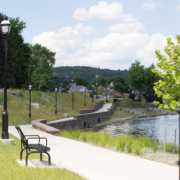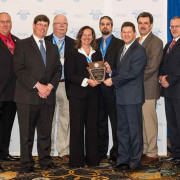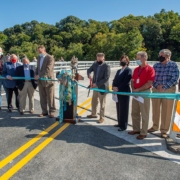Benefits of Traffic Signal Retiming Outweigh Costs 40:1

This article was published in the June 2010 issue of Borough News magazine and is reprinted here with their permission.
If someone told you that you could spend as little as 1 percent of your transportation budget on an effort with up to a 40:1 return on that investment, would you believe him? If he’s talking about traffic signal retiming, you should.
Often overlooked in favor of more high profile construction projects, traffic signal retiming is an inexpensive but hugely cost-effective effort that returns wide-ranging benefits, including reduced congestion and driver delay, reduced fuel consumption, and reduced air pollution, among others. And the Institute of Transportation Engineers estimates these benefits could be gained for as little as 1% of public transportation funding but would return benefits outweighing the cost by 40:1. In this economic climate, that’s an investment that’s hard to beat.
Benefits of Traffic Signal Retiming
The goal of traffic signal retiming is to minimize the time vehicles moving in any direction have to wait at an intersection. It involves prioritizing the signals in your community; determining which signals or groups of signals exhibit the most delay; collecting data on the current operations of the signal, including traffic counts and turning movements; modeling the traffic to determine a new timing plan; adding the revised timing plan to your Traffic Signal Permit Plan; and submitting it to PennDOT for review.
Once PennDOT approves the plan, it is implemented and monitored to determine if any further fine-tuning is necessary. The primary reason municipalities consider traffic signal retiming is to reduce congestion and driver delay, but this is just one of many benefits of properly timed traffic signals:
- According to studies by the Institute of Transportation Engineers, traffic signal retiming reduces motorist delay at an intersection by 15-37 percent and reduces the motorist’s overall travel time by seven to 13 percent.
- Reduced travel time and delay, in turn, decreases motorist frustration.
- The Institute of Transportation Engineers also estimates that properly timed signals decrease fuel consumption by six to nine percent.
- Properly timed signals reduce vehicle emissions, as well, thereby improving air quality.
- In addition, properly timed signals reduce the number of collisions on municipal streets by producing smoother traffic flow and fewer stops. Smoother traffic flow also reduces driver aggression.
- Improving traffic flow on signalized streets minimizes the number of drivers who take side streets in order to avoid congestion on the main corridors. This will then minimize the congestion and safety problems (as well as wear and tear) caused by use of these streets beyond what they were designed to handle.
Costs and Funding Options
So why don’t more communities retime their traffic signals? Historically, traffic signal retiming has been seen as one more item in a long list of needs competing for limited public transportation funds. Plowing, salting, and paving can exhaust a significant portion of Liquid Fuels monies. If traffic signals are considered at all, it is to replace an extinguished signal lamp or to fix broken equipment.
But traffic signal retiming is an inexpensive effort that can reap huge rewards. On average, a traffic signal retiming effort costs between $1,500 and $2,500 per signalized intersection. What’s more, a creative engineer with knowledge of the transportation funding process can help you find funding sources for a traffic signal retiming effort in order to reduce the burden on your borough budget.
For example, the SAFETEA-LU federal transportation funding program included a program called Congestion Management/Air Quality (or CMAQ), which has two goals: to reduce congestion and improve air quality – two of the main benefits of traffic signal retiming. This program has been used effectively across the nation to help local communities fund traffic signal retiming efforts.
In many cases, regional organizations (such as councils of government or regional metropolitan planning organizations) have banded together using CMAQ funds to assist their local municipalities with traffic signal retiming programs. Here in Pennsylvania, the Southwestern Pennsylvania Commission, a metropolitan planning organization that covers 10 counties surrounding the City of Pittsburgh, engaged a consulting team of which Herbert Rowland and Grubic is a team member, embarked on such an effort in 2008 which is currently ongoing.
The federal SAFETEA-LU bill has expired and is operating under continuing resolution while a new bill is developed. It is unknown what the final form or format of the types of funding programs will be in the next bill, however it has been reported that there will be an emphasis on the reduction of congestion, greenhouse gas emissions, and improve air quality.
When should signal retiming be implemented in your community?
A municipality should develop a program for the routine traffic signal retiming of all of the signals within the community. The program should place a priority for retiming on each signal in an effort to ensure that the signals with the most impact on the traveling public are retimed most often.
The Institute of Transportation Engineers recommends that all traffic signal timing plans be re-evaluated, at minimum, every three years to account for normal growth in traffic demand. It is also important to retime signals any time new homes or businesses are constructed or a shift occurs in the location of employment centers within a community. Such changes inevitably alter traffic patterns, necessitating revisions to the traffic signal timing plans.
Who should implement signal retiming in your community?
It is important to engage professionals to aid in the development and implementation of a traffic signal retiming program. It is recommended that these professionals be individuals with specific training and experience in signal retiming and certification as a Professional Traffic Operations Engineer (PTOE). A PTOE is a person who applies a comprehensive knowledge of technology and scientific principles acquired through study and experience to the supervision of day-to-day operation of traffic systems. To become certified as a PTOE one must have a valid license to practice engineering (P.E.), a minimum of four years of experience, and pass a written certification examination.
As stewards of the public dollar, borough officials are constantly seeking the most cost-effective ways to improve the quality of life for their community, and, with benefits that outweigh the costs by 40:1, traffic signal timing is perhaps one of the best ways they can accomplish this goal.
For as little as $1,500 per intersection, your borough can enjoy wide-ranging benefits such as reduced congestion and motorist delay, reduced fuel consumption, and improved air quality. Moreover, funding is available to those who are creative in order to offset the cost of this inexpensive effort.
If your community has experienced residential or business construction or you simply have not examined your traffic signal timing in more than three years, now is the time to revisit your signal timing plans.








